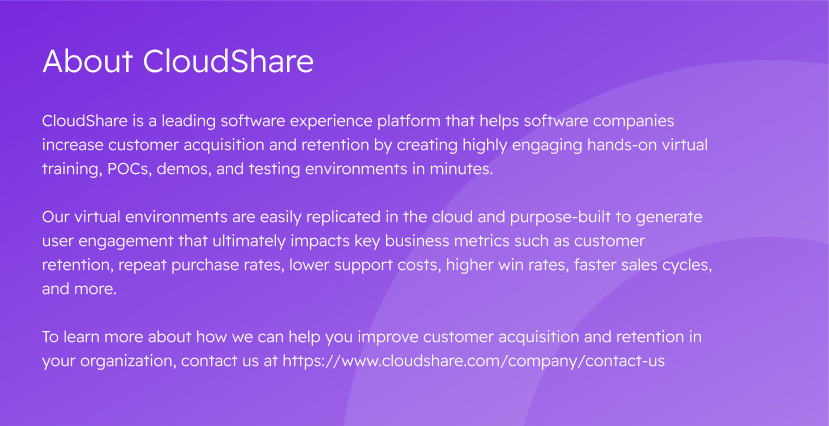
Virtual training
The State of Virtual Software Training in 2023
How Training Can Recession-Proof Your Organization
Executive Summary
In 2023 organizations are facing widespread layoffs (especially in the tech industry), high inflation, and talk of an economic downturn. While the pandemic officially ended, certain changes are here to stay; notably, we can no longer assume that people are working and learning in person: by the end of 2023 39% of global knowledge workers are expected to work hybrid. In this context, virtual software training for employees and customers should not be viewed simply as part of a remote work toolbox. Instead, it represents a key business strategy to future-proof organizations by retaining employees, satisfying customers, and even compensating for understaffing. Yet training leaders face an urgent challenge: in order to effectively show value, they must align training metrics with their organizations’ overall business goals.
Methodology
Every year, CloudShare runs a survey to collect data and analyze the state of the virtual software training industry. Virtual software training refers to remote learning experiences, whether self-paced or instructor-led, that enable employees and/or customers to build their skills with software. In 2023 we surveyed 151 respondents, primarily Training Managers and Directors. We used PureSpectrum to find and survey respondents in our core demographic during February 2023. 27% of respondents are in small organizations of 151–500 people, 27% of respondents are in mid-sized organizations of 501–1000, and 71% are in large organizations of 1000+1. Training budgets range from less than $10,000 to more than $100,000.
Key Findings
- Despite widespread layoffs and pressure to trim budgets, in 2023 virtual software training remains a priority. In most organizations, training budgets are increasing 10–17% in 2023.
- Virtual labs are increasingly viewed as indispensable for hands-on learning; 53% of respondents are using virtual labs and an additional 29% plan to purchase one.
- Organizations are facing understaffing and using self-paced training as a method to cope. Meeting the needs of understaffing as a virtual software training goal doubled between 2022 and 2023, increasing from 17% to 36%.
- Perhaps the most pressing issue in virtual software training is ensuring that it serves business objectives. Yet in 2023, only 20% of our survey respondents viewed their training program KPIs as very well aligned to business goals, while 66% reported that they were somewhat aligned and 14% reported little to no business alignment.
- As a training investment priority, customer experience rose 50% and analytics tools rose 118% in 2023 compared to 2022.
——————————————————————————-
1 – In this survey, all percentages are rounded based on the following:
0.5+ = to the higher percentage point
0.49- = to the lower percentage point
This may mean that totals do not add up to 100%
Focus on Virtual Software Training
In 2023, virtual software training remains a priority in most organizations, with self-paced training as the dominant model and virtual labs increasingly indispensable.
1. Training Budget Changes in 2023
In 2023 virtual software training is important to most organizations. Despite widespread layoffs and pressure to trim budgets, most organizations’ software training budgets have grown slightly since 2022. While organizations with training budgets of $10,000–50,000 are seeing annual budgets decline by 15–20%, the majority of organizations (both those with budgets smaller than $10,000 and those larger than $80,000) have actually seen budgets increase 10–17%. This prioritization makes sense: for example, Forrester reports that 90% of companies have seen a positive return on their customer education investments.
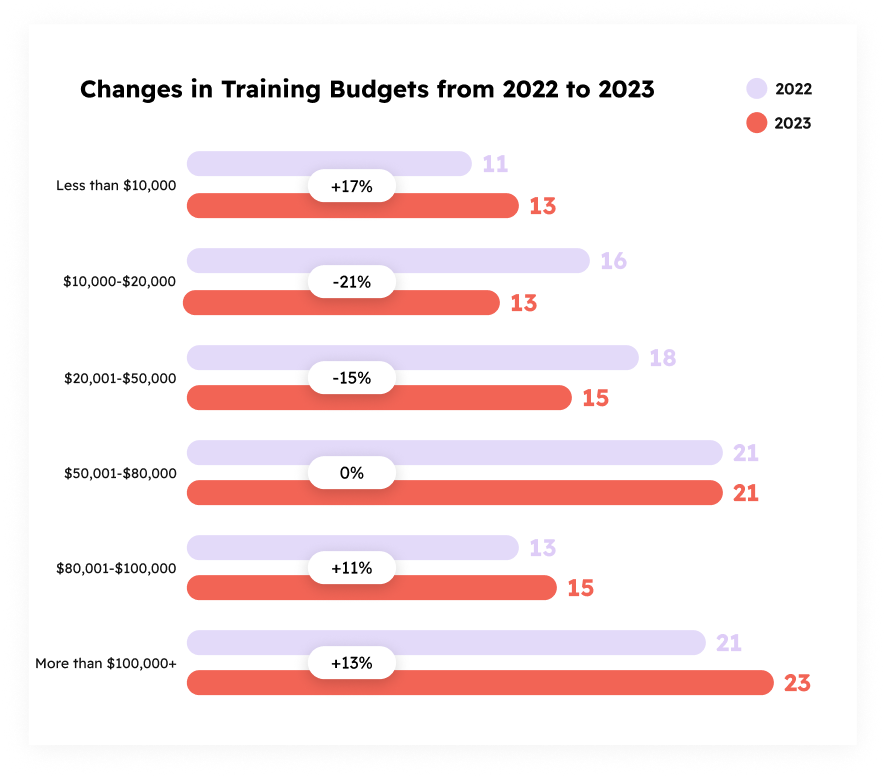
Figure 1. Training budget changes from 2022 to 2023

2. Self-Paced Training
Self-paced training has staying power as the dominant virtual software training model, with 58% of respondents using it as their main training method in 2023. These rates have stayed largely consistent from 2022 to 2023.
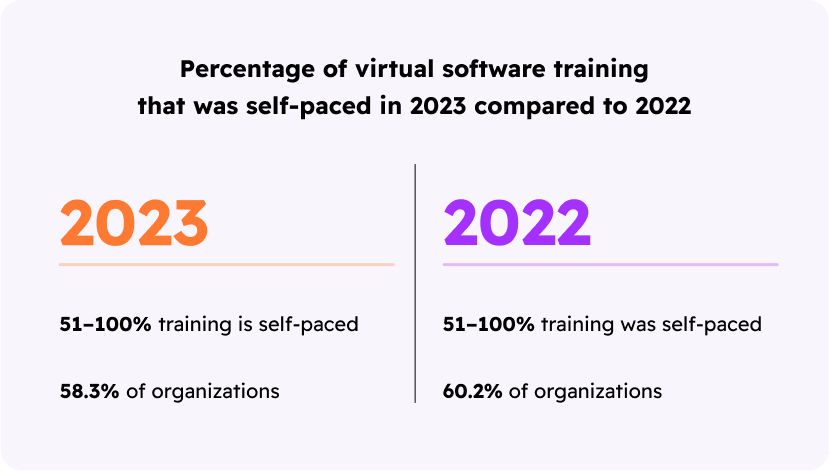
Table 1: Percentage of virtual software training that was self-paced in 2023 compared to 2022
When well implemented, self-paced training gives employees and customers the freedom to learn anytime, anywhere–while saving organizations time and money. Organizations choose self-paced training for a number of reasons.
- Prospective customers are not always able to attend virtual instructor-led training (VILT) due to scheduling conflicts.
- Larger software companies may have a customer base that spans multiple time zones, making it difficult (perhaps impossible) to schedule sessions that consistently work for everyone.
- 58% of people prefer the flexibility to learn their own way and at their own pace.
Ideally, self-paced training should be a hands-off way to deliver hands-on experiences. The best training platforms guide students through flexible, multi-step programs that ensure greater knowledge retention.
3. Virtual Labs in Online Training
In 2023 virtual labs are becoming increasingly indispensable within online training. In our survey, 53% of respondents are using virtual labs, while an additional 29% plan to purchase one.
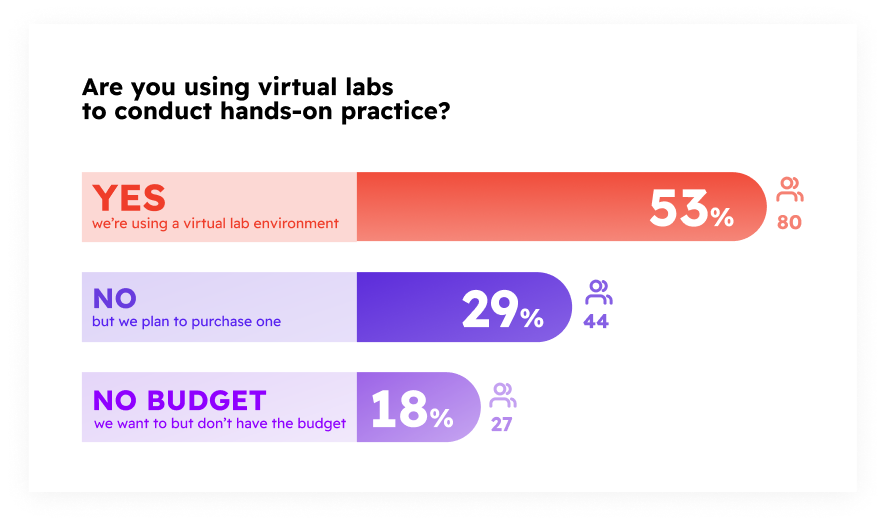
Figure 2. Percentage of organizations using virtual lab environments
Organizations value virtual labs for both employees and customers because learners need to be able to practice new skills. In virtual labs, trainees can gain experience using software in safe, sandboxed environments. These real-world scenarios encourage active learning and knowledge retention.
For ease of implementation, organizations often look for virtual labs that can be created using just a web browser and an internet connection, and can be deployed in any public cloud environment.

Priorities in Virtual Software Training
Organizations’ priorities in their virtual software training programs have shifted dramatically since 2022, with compensating for understaffing becoming a key goal in 2023. This is reinforced by organizations’ main challenges in implementing virtual software training, where understaffing is the #1 obstacle.
4. Goals for ILT and Self-Paced Training
Facing economic pressures in 2023, companies have taken a defensive approach. Virtual software training is viewed as a key tool to upskill and retain employees as well as to satisfy and retain customers, as reflected in the responses to our survey question about goals for instructor-led training (ILT) and self-paced training.
These priorities make sense in organizations focused on the bottom line. Improving customer retention by 5% can increase profits 25–95% and is far more affordable than customer acquisition – and effective software training increases customer retention. Likewise, retaining employees make financial sense; according to Gallup, a conservative estimate of the cost of replacing an individual employee ranges from one-half to two times the employee’s annual salary.
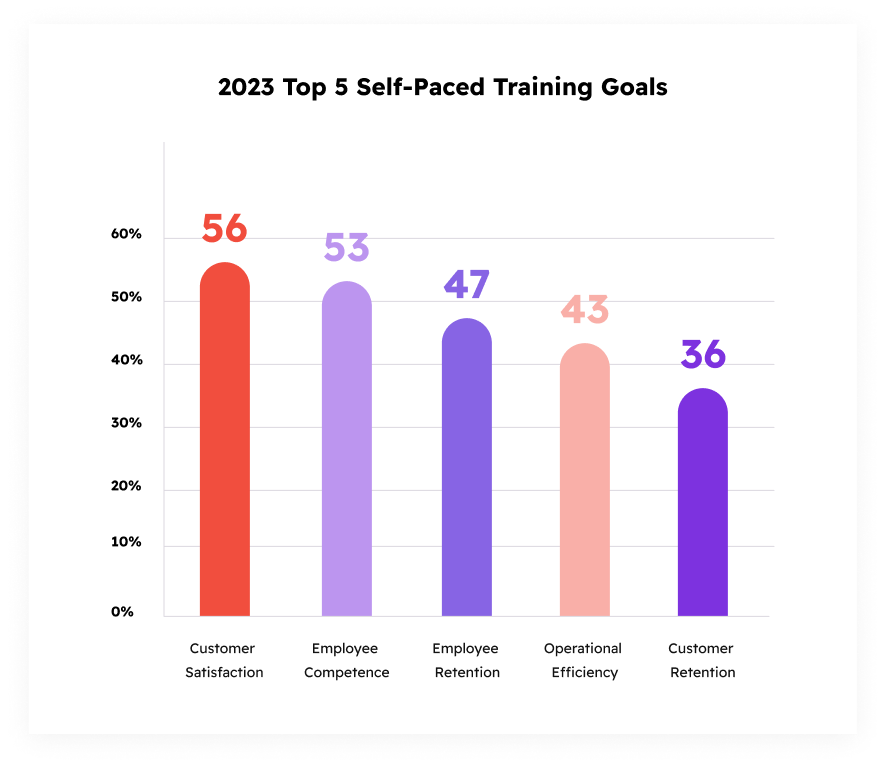
Figure 3. Top 5 Self-Paced Training Goals in 2023
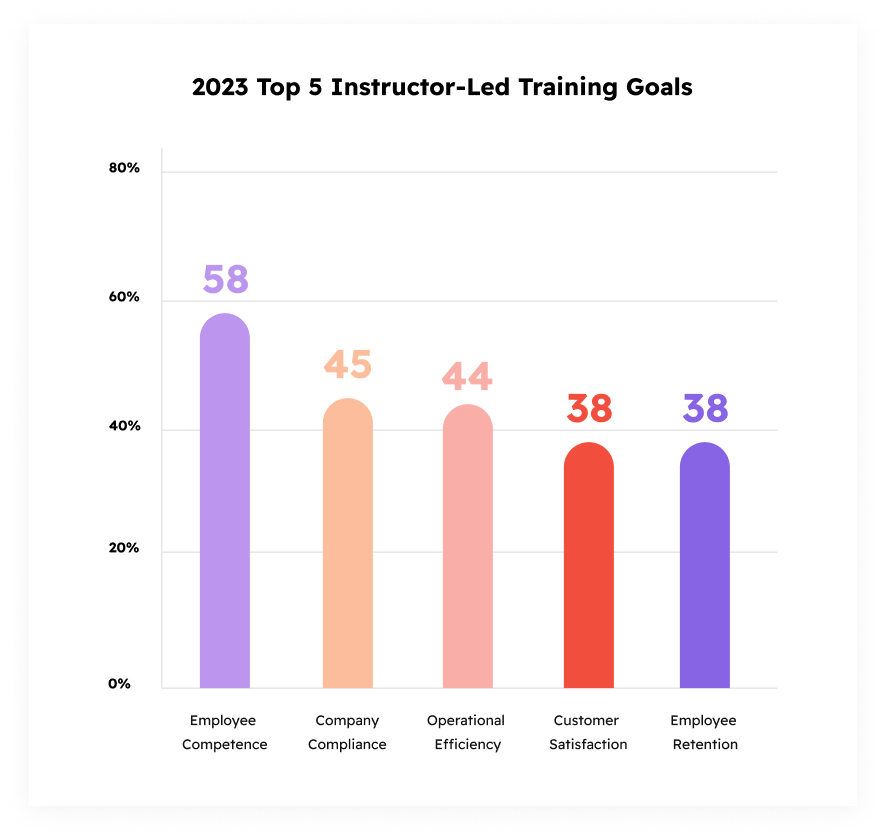
Figure 4. Top 5 ILT Training Goals in 2023
Notably, meeting the needs of understaffing as a training goal doubled between 2022 and 2023, increasing from 17% to 36%. This further underscores how organizations are prioritizing virtual software training as a strategy when budgets are tight.

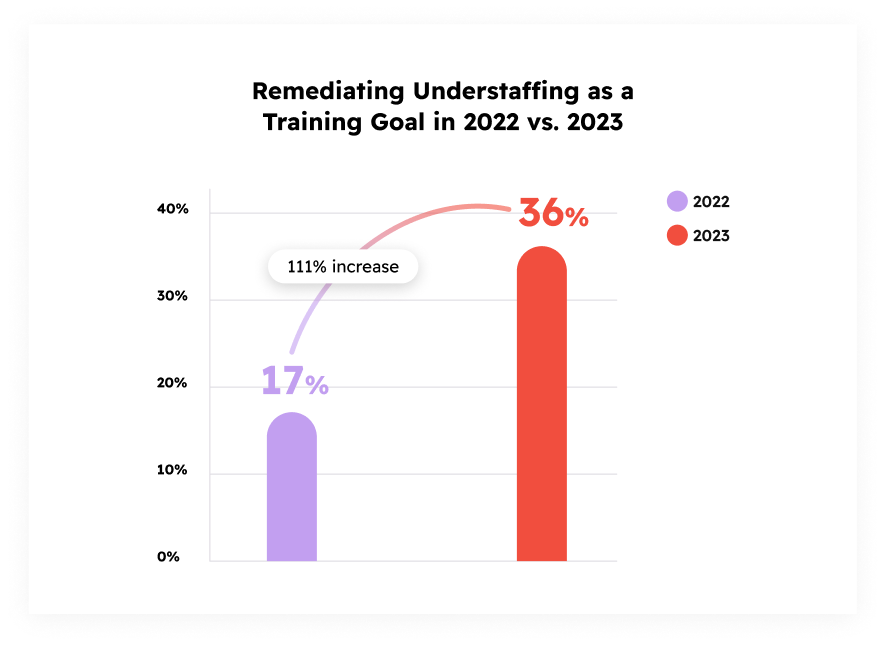
Figure 5. Remediating understaffing as a virtual software training goal in 2022 and 2023
5. Top 3 Challenges in Meeting Virtual Software Training Goals
The top three challenges in meeting virtual software training goals in our survey reinforce our finding in section 4 that companies are coping with widespread understaffing. While scheduling has stayed a consistent training challenge from 2022 to 2023, internal understaffing rose to become the #1 cited challenge of 2023.
In this environment of being asked to do “more with less,” training professionals must be laser-focused on showing the value of virtual software training programs by aligning training metrics with business goals–tied as the #2 challenge in 2023. Business alignment escalated as a top challenge in 2023, increasing by 120% over 2022.
User engagement also made the top 3 in 2023, underlining the importance of high quality learning experiences to satisfy the goals discussed in section 4, such as customer satisfaction and employee competence.
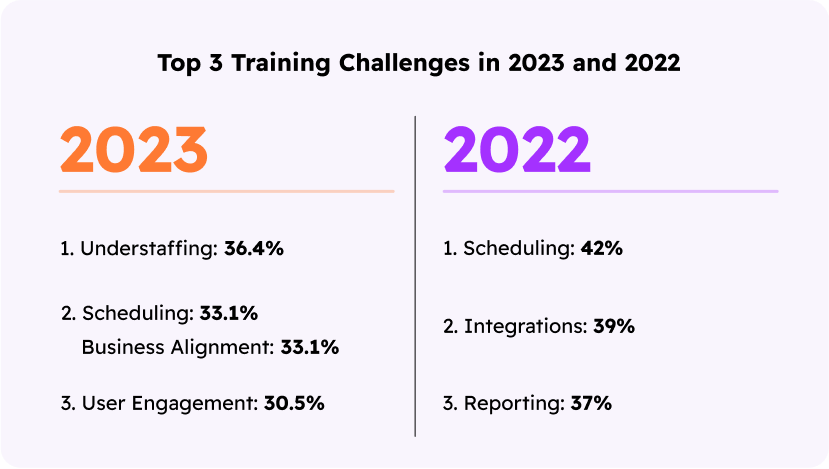
Table 2: Top 3 Training Challenges in 2023 and 2022
The number of survey respondents ranking alignment between training metrics and business metrics as a top challenge jumped by 120% in 2023 compared to 2022, from 15% to 33%.

Figure 6. Business alignment as a top challenge in 2022 and 2023
Virtual software training is easily scalable, a benefit in an environment of staff and budget cuts. Organizations can avoid training bill surprises by relying on platforms that can be spun up quickly and automatically suspended, based on customizable policies. Scheduling, a perennial challenge, can be made more efficient with a platform that automatically sends all invites and instructions to students.
Improving business alignment necessitates breaking down silos to ensure communication and collaboration across roles and departments. As we will discuss in the next section, a training program with baked-in analytics is also indispensable.
Horizon for Virtual Software Training
Perhaps the most pressing issue in virtual software training is proving value, ensuring that it is demonstrably serving the organization’s business objectives. This issue surfaces in the top challenges discussed in section 5, and reappears both in respondents’ self-evaluation of how well their software training aligns with business goals, as well as their training investment priorities going forward.
6. Aligning Virtual Software Training KPIs to Business Goals
As discussed in section 5, aligning software training key performance indicators (KPIs) with business goals is more important than ever in the context of tightening budgets and even concerns about a downturn. Yet in 2023, only 20% of our survey respondents viewed their training program KPIs as very well aligned to business goals, while 66% reported that they were somewhat aligned and 14% reported little to no business alignment.
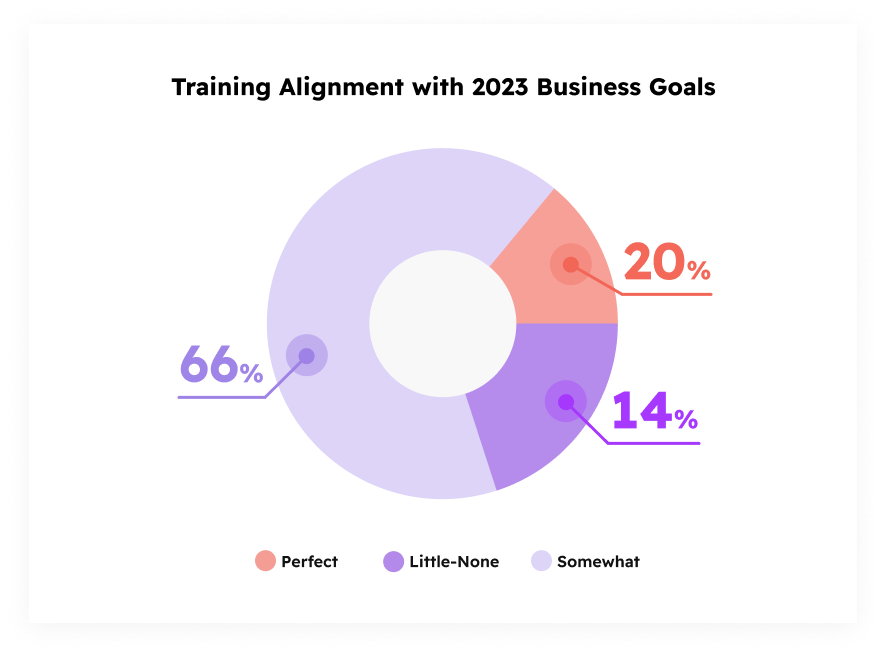
Figure 7. How well training KPIs align with business goals
A few important steps can help to address issues with business alignment.
- To show alignment and prove value, training programs must be measurable. Organizations should look for training platforms that have baked-in analytics.
- To understand and support business goals, training teams must have a seat at the table when strategic discussions take place among product, sales, and marketing teams. This way, training teams are up-to-date about new developments (e.g., new product features) and business goals, and can offer the most relevant training.
- Additionally, since training teams are often closest to customers, they can offer valuable insights into customer experiences for other teams.
- Once training departments are aware of organizational KPIs, they must ensure that training KPIs align (e.g., increasing product adoption, decreasing customer churn). All training programs should have clear, measurable goals.

7. Training Investment Priorities
Our survey results show that several training investment priorities jumped in importance in 2023 compared to 2022. Analytics tools rose to be a top priority among 48% of respondents, a 118% increase over 2022. This indicates that training teams are recognizing the need to measure performance in order to show value and ensure alignment with business objectives.
Customer experience rose 50% as an investment priority in the past year, reinforcing the findings in sections 4 and 5 that organizations are taking a defensive approach to virtual software training, with retaining current customers as a focus.

Curriculum and content management as an investment priority also rose dramatically, by 372%, suggesting that some current training programs and platforms are underperforming in this area.
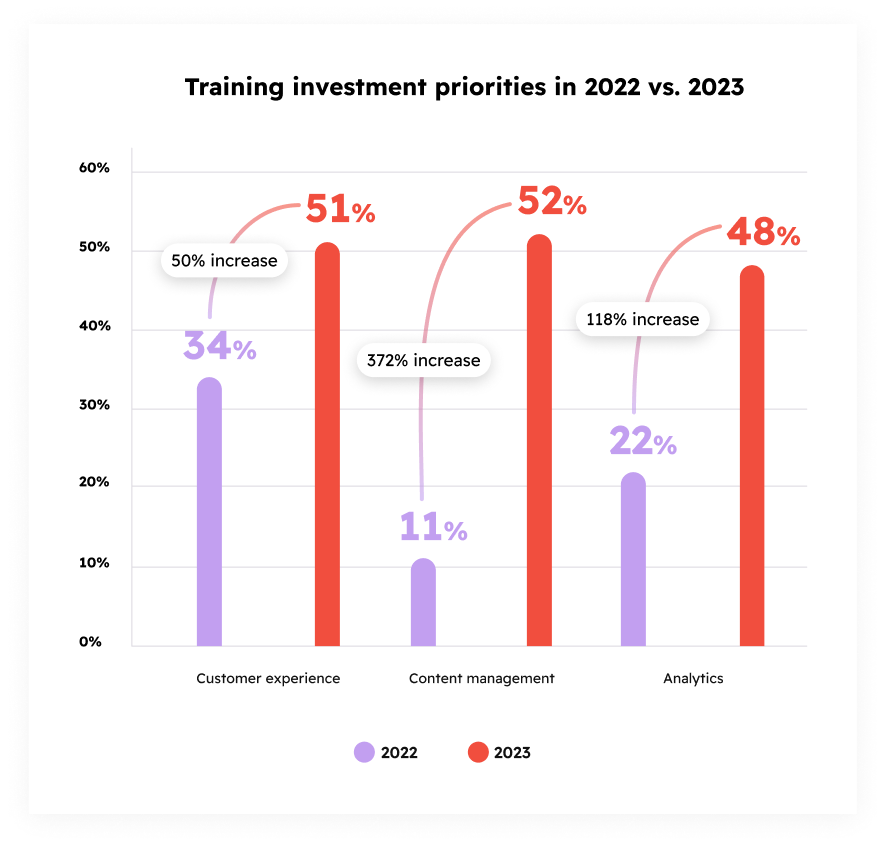
Figure 8. Training investment priorities in 2023 compared to 2022
Recommendations
How to “Do More With Less in 2023”
Our 2023 survey about the state of virtual software training shows that organizations are taking a defensive approach to training, focusing on customer and employee retention, and leveraging self-paced training to help compensate for understaffing. In the current context of layoffs and budget cuts, one of the most crucial issues facing training departments is to show their value by effectively aligning training KPIs with business goals.
Following are five key recommendations extrapolated from our survey results.
1. Prioritize great learning experiences
Organizations care deeply about customer experience and customer and employee retention–so focusing on delivering effective, hands-on learning experiences is a no-brainer. To appeal to a variety of people, offer a mix of scalable and measurable one-to-many training programs (with VILT or self-paced training). Training platforms that support in-app video and audio, over-the-shoulder functionality, classroom chat, and quizzes can provide real-time student-teacher and peer interaction.
2. Focus on analytics
Look for training platforms that have baked-in analytics. Then create a scoring system; all training programs should be evaluated according to how well they meet expected KPIs. Training programs that fail to meet KPIs should be iterated and improved, or shelved for later.
3. Invest in a virtual lab
(If you have not already.) Virtual labs are becoming increasingly indispensable for organizations to offer hands-on training experiences. In virtual labs, trainees can gain experience using software in safe, sandboxed environments. These real-world scenarios encourage active learning and knowledge retention.
For ease of implementation, look for virtual labs that can be created using just a web browser and an internet connection, and can be deployed in any public cloud environment.
4. Manage training costs
Virtual software training is easily scalable and often more cost effective than in-person training. Rely on platforms that can be spun up quickly and automatically suspended, based on customizable policies. You should never have surprises on your training bill. Lean on best practices for cost control in training. A training platform that easily integrates with an organization’s LMS of choice is another way to improve efficiency.
5. Give training internal visibility
Make sure training leaders are at the table when business strategy is discussed. Broadcast department successes to the larger organization and upper management.
